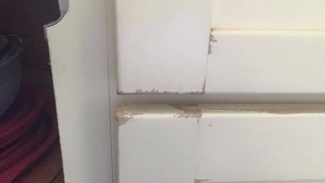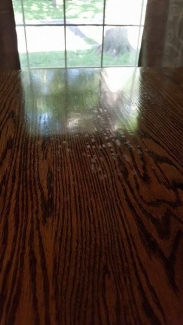

There are no guarantees with silicone - it is almost impossible to remove. If the silicone has migrated into the wood through cracks in the old finish, you may not be able to get it all removed.
Unfortunately, silicone contaminants, often from dusting sprays, do not become apparent until a new finish is applied and generally cannot be removed from the surface, only moved around and possibly sealed - a bane of the refinishing industry.
You need to power clean the existing finish and put on some type of barrier coat:
If your current finish is chipping, it is failing to adhere correctly. The adhesion problem could be caused by several reasons:
Even though there is internet chatter about removing wax with 3rd party products, mineral spirits or vinegar, none guarantee success.
There is an old saying in the industry. "Once you wax, you cannot go back". Nothing adheres well to wax and even after cleaning, the wood grain can become contaminated. Wax can penetrate the wood, making future paint or stain finishes or touch-ups difficult or impossible.
There are several reasons:
1. The cabinets were not prep cleaned and sanded properly. Sanding and cleaning are an essential part of any refinishing process.
In most cases, you can use a 220 sanding pad to scuff the surface and clean with a 50|50 mix of water and denatured alcohol.
This response is true of prepping and existing finish on furniture, but kitchen cabinets are more problematic because they are work areas where grease, steam, food splatters and oil from hands are common. Prep is basically degreasing and abrading the surface for better adhesion. Oil or substances on hands really show up on a failed re-finish around doorknobs and hands if the surface is not cleaned thoroughly.

If your current finish is chipping, it is failing to adhere correctly. The adhesion problem could be caused by several reasons:
Although some companies promote their products as "no prep," that is nonsense. If you skip this step the finish can fail. General Finishes's standard for a good finish is it must adhere well and stand the test of time.
There is no easy solution to this problem. General Finishes Milk Paint has strong adhesion properties but there are several reasons this finish could fail:
Although some companies promote their products as "no prep", that is nonsense. If you skip this step the finish can fail.
General Finishes standard for a good finish is it must adhere well and stand the test of time.
1. PREP CLEANING:
Cleaning an existing finish removes dirt, grime and many common contaminants such as oil from hands. Dirt, grime, and oil prevent good adhesion causing the possibility of chipping, peeling and flaking - all signs of a failed finish.

The problem areas on your table are probably caused by surface contamination from oils, waxes or cleaning products used over the years.
Contaminants from dusting sprays that contain silicone will also impact the appearance and adherence of a finish - silicone is almost impossible to remove. Oil soaps and wax can also cause adhesion failures. This may be why the finish is performing differently on the leaves vs the table top. Adhesion failure is often more obvious in the deepest patterns of grain because the contamination is driven deep into the grain.